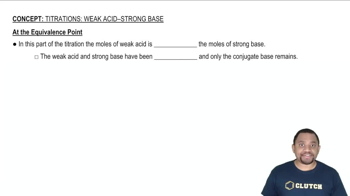A 30.0-mL sample of 0.165 M propanoic acid is titrated with 0.300 M KOH. Calculate the pH at each volume of added base: 5 mL.
Ch.17 - Aqueous Ionic Equilibrium
Chapter 17, Problem 72e
A 30.0-mL sample of 0.165 M propanoic acid is titrated with 0.300 M KOH. Calculate the pH at each volume of added base: one-half equivalence point.
 Verified step by step guidance
Verified step by step guidance1
Identify the reaction: Propanoic acid (CH₃CH₂COOH) reacts with KOH to form propanoate ion (CH₃CH₂COO⁻) and water.
Determine the moles of propanoic acid initially present using the formula: \( \text{moles} = \text{concentration} \times \text{volume} \).
Calculate the volume of KOH needed to reach the equivalence point using the stoichiometry of the reaction and the initial moles of propanoic acid.
Find the volume of KOH at the one-half equivalence point, which is half of the volume needed to reach the equivalence point.
At the one-half equivalence point, the concentration of propanoic acid equals the concentration of propanoate ion, so the pH equals the \( pK_a \) of propanoic acid. Use the \( pK_a \) value to determine the pH.

Verified video answer for a similar problem:
This video solution was recommended by our tutors as helpful for the problem above.
Video duration:
1mWas this helpful?
Key Concepts
Here are the essential concepts you must grasp in order to answer the question correctly.
Titration
Titration is a quantitative analytical technique used to determine the concentration of a solute in a solution. It involves the gradual addition of a titrant (in this case, KOH) to a solution containing the analyte (propanoic acid) until the reaction reaches its equivalence point, where stoichiometrically equivalent amounts of acid and base have reacted.
Recommended video:
Guided course

Acid-Base Titration
Equivalence Point and Half-Equivalence Point
The equivalence point in a titration is the stage at which the amount of titrant added is stoichiometrically equivalent to the amount of substance in the sample. The half-equivalence point occurs when half of the acid has been neutralized, which is significant because it allows for the calculation of pH using the Henderson-Hasselbalch equation, as the concentrations of the acid and its conjugate base are equal.
Recommended video:
Guided course

At the Equivalence Point
Henderson-Hasselbalch Equation
The Henderson-Hasselbalch equation relates the pH of a solution to the pKa of the acid and the ratio of the concentrations of the conjugate base to the acid. It is expressed as pH = pKa + log([A-]/[HA]). At the half-equivalence point, the pH equals the pKa of the acid, simplifying the calculation of pH in buffer solutions.
Recommended video:
Guided course

Henderson-Hasselbalch Equation
Related Practice
Textbook Question
Textbook Question
A 30.0-mL sample of 0.165 M propanoic acid is titrated with 0.300 M KOH. Calculate the pH at each volume of added base: 10 mL.
Textbook Question
A 30.0-mL sample of 0.165 M propanoic acid is titrated with 0.300 M KOH. Calculate the pH at each volume of added base: equivalence point.
Textbook Question
A 30.0-mL sample of 0.165 M propanoic acid is titrated with 0.300 M KOH. Calculate the pH at each volume of added base: 20 mL.
Textbook Question
A 30.0-mL sample of 0.165 M propanoic acid is titrated with 0.300 M KOH. Calculate the pH at each volume of added base: 25 mL.
Textbook Question
Consider the titration of a 25.0-mL sample of 0.175 M CH3NH2 with 0.150 M HBr. Determine each quantity. a. the initial pH
